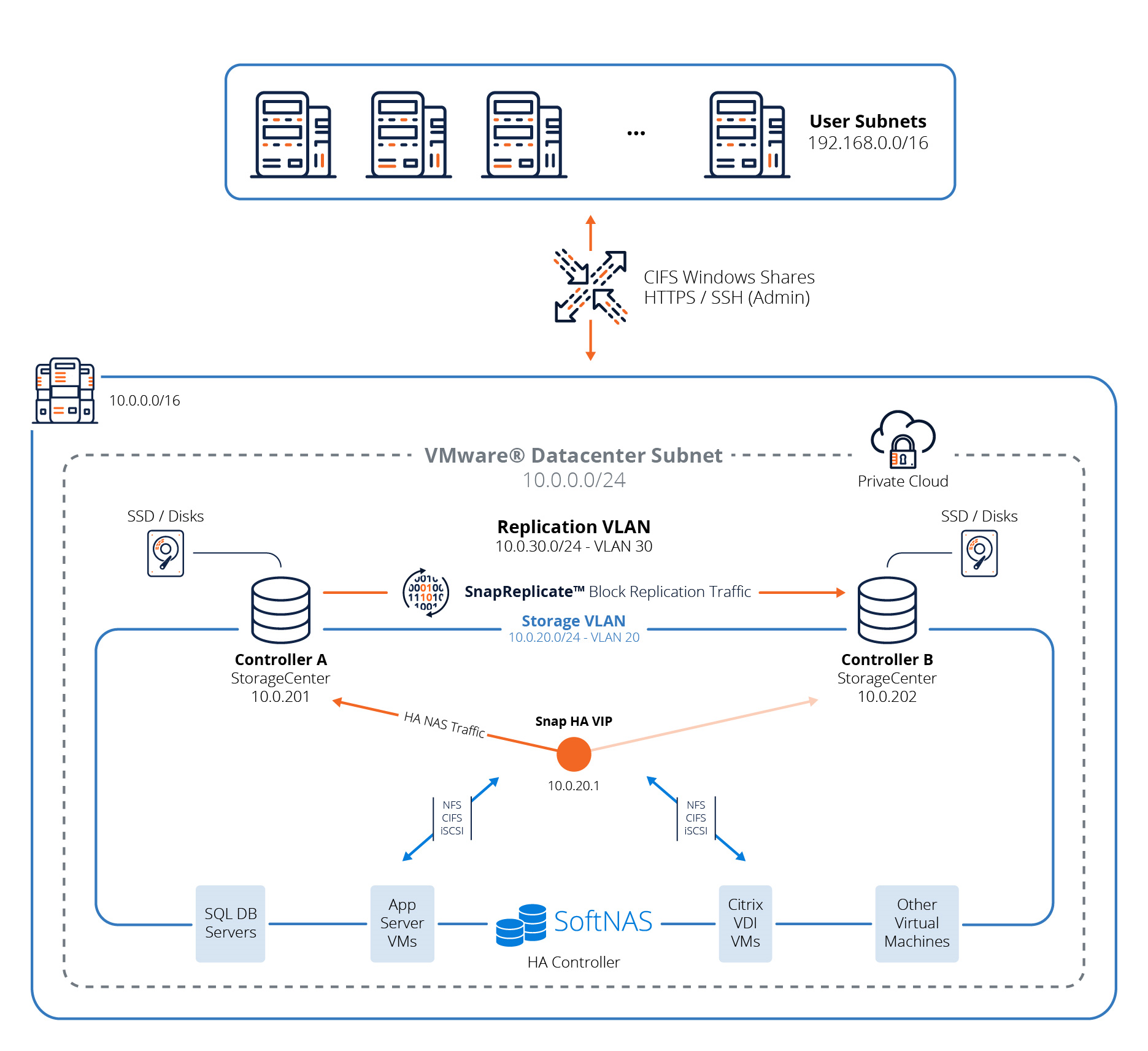VMware vSphere HA (High Availability)
VMware vSphere HA (High Availability) is a utility included in VMware’s vSphere software that can restart failed virtual machines (VMs) on alternative host servers to reduce application downtime.

HA in VMware vSphere High Availability Solution
SoftNAS complements VMware virtual with an extensive NAS feature set, combined with unified storage access via NFS, CIFS/SMB, with Active Directory integration. SoftNAS extends the VMware environment to include highly durable Amazon S3 cloud storage, with additional petabytes of secure off-site cloud storage.
SoftNAS runs as a virtual appliance on VMware ESXi and the SoftNAS VM is allocated clustered storage from. Storage volumes are allocated from storage pools and shared as NFS exports and VIDS/SMD shared. Integration with Active Directory provides authentication and authorization features.
SoftNAS SNAP HA High Availability
SoftNAS SNAP HA ™ on VMware VSphere easily fits within a modern, virtualized data center. Today’s data center is often running VMware, with a network architecture comprised of several VLANs used to segregate various classes of network traffic. The diagram below shows one such network topology, which implements best practices for SoftNAS SNAP HA™ in the data center.

User subnets are allocated outside the data center network and traverse one or more routers to reach the data center.
The data center network exists on its own /16 (or similar) layer 2 networks, which we term the “Datacenter Primary Subnet”. This subnet is used for administrative and other default traffic.
A separate “Replication VLAN” and corresponding subnet are allocated for SoftNAS® block replication traffic; i.e., SnapReplicate™ is configured to flow across this dedicated VLAN, which prevents data replication traffic between controllers from impacting storage or other data center services. During high periods of I/O, data replication on a 1 GbE network can reach sustained levels of 120 MB/sec as multiple streams of block replication take place across controllers, so the replication VLAN is an important consideration.
A separate “Storage VLAN” and corresponding subnet is allocated for SoftNAS® primary virtualization storage traffic; i.e., NFS and iSCSI traffic between VMware vmKernels on each VM host responsible for storage access. Assigning a separate vSwitch and physical NICs to storage is essential for achieving maximum throughput and IOPS, and for keeping storage access isolated from other network segments. If storage is not isolated on its own VLAN, vSwitch, and physical NICs, performance will be impacted, and high storage I/O loads will impact other services.
StorageCenter and routine, lower-priority storage traffic (e.g., from the User Subnets) can be routed across the default data center network if the simplicity of network topology is desired. Alternatively, certain protocols (e.g., CIFS for Windows shares) could be routed to the Storage VLAN and HTTP/HTTPS/SSH routed to the default data center network for SoftNAS StorageCenter™ access and administration.
In the example shown above, VLAN 30 is assigned to SNAP HA™ replication. VLAN 20 is assigned to as the Storage VLAN. A special “Elastic HA™” IP address is configured within the Storage VLAN subnet to act as a virtual IP address. SoftNAS SNAP HA™ uses ARP IP aliasing to route the Elastic HA IP address to the proper SoftNAS® Controller.
Buurst offers SoftNAS Free Trial on VMware
Create affordable, powerful private and hybrid cloud storage solutions combining the power and flexibility of software-defined VSAN and SoftNAS Cloud NAS on VMware in just minutes!
Use this simple, step-by-step checklist to set up and configure the SoftNAS instance on VMware.
- Login to your VMware vSphere client with your credentials.
- Download the SoftNAS OVA and save it to the host it will be installed on
- Login to your vSphere client and select the ESXi that you will be using. Click “File” from the navigation bar and then “Deploy OVF Template.” Click “Browse” to locate the SoftNAS OVF and select it.
- Click “Next,” then select “Next” again on OVF Template Details. Select the host you want to deploy on and select “Next.” Select a resource pool and then click “Next.”
- Select your destination storage and click “Next.” Select a disk format and click “Next.” Select a network for your VM to use.
- Click “Finish.” The SoftNAS VM will be deployed after a short interval.
Elastic HA (High Availability) IP in VMware vSphere
The Elastic HA IP in VMware is implemented as a virtual IP termed a “VIP”; that is, an IP address that can be quickly reassigned using a combination of ARP and local interface commands. Choose a VIP address that is within the Storage VLAN subnet. In the example shown below, a VIP of 10.0.20.100 would work fine. The VIP must not be manually assigned to any interface. During installation and set up of SNAP HA™, the VIP will be automatically configured and assigned to the primary controller and then managed by SNAP HA™.

High Availability Controller VM – VMware virtualization environments
In the VMware virtualization environments, a 3rd SoftNAS® VM is installed to act as the “HA Controller”
The HA Controller acts as an independent, 3rd party witness and controller to all SNAP HA™ failover and take-over operations. The HA Controller keeps track of which SoftNAS® storage controller is operating as the Primary controller. This prevents the possibility of “split-brain” or other potential cluster management maladies that could otherwise occur when only two cluster nodes are present, by fencing off failed controllers and ensuring they are not allowed to come back online and pose as a primary storage controller.
In a VMware HA environment an HA Controller deployed as an “FT” (fault-tolerant) VM is required. HA Controllers are relatively lightweight versions of SoftNAS®, only requiring 512 MB of RAM and 1 vCPU, and have relatively little network traffic or data change, so they pose relatively little resource overhead vs. the added peace of mind of always knowing that storage HA operations will remain consistent, no matter what takes place across the virtualization environment.
The HA Controller is required for both production and test environments to ensure proper HA operation always takes place. If no HA Controller is deployed, IT administrators would instead have to assume all responsibility for keeping track of failovers and ensuring controllers with old data are not brought online before the most recent primary controller. As this would defeat the purpose of automated failovers, and the premise behind high availability, SoftNAS requires HA controllers for all VMware HA configurations.

SoftNAS was a good fit for us because while we’re on-premises, we wanted something that was performant, flexible, and scalable… and lend themselves to being moved and implemented in the cloud.”
Jerry Nihen, Sr Systems Engineer, CMG Financial

VMware SNAP HA ™ Setup
Set up SNAP HA™ in any VMWare virtualized environment See Set up guide.
For more information about SNAP HA™ networking best practices, see section HA Design Principles.
For more information about common SoftNAS® installation procedures, see the document SoftNAS Installation Guide.
SoftNAS VMware NAS Storage solution enables organizations of all sizes to leverage their existing investment in VMware platforms and tools to deploy powerful software-defined storage capabilities. SoftNAS supports all VMware-compatible storage media and network hardware and is compatible with all private, public, and hybrid cloud platforms. This flexibility has driven customer interest from industries that often face limited IT capital resources, ranging from small-to-medium businesses, educational institutions, government entities, media or publishing companies, and service providers.

